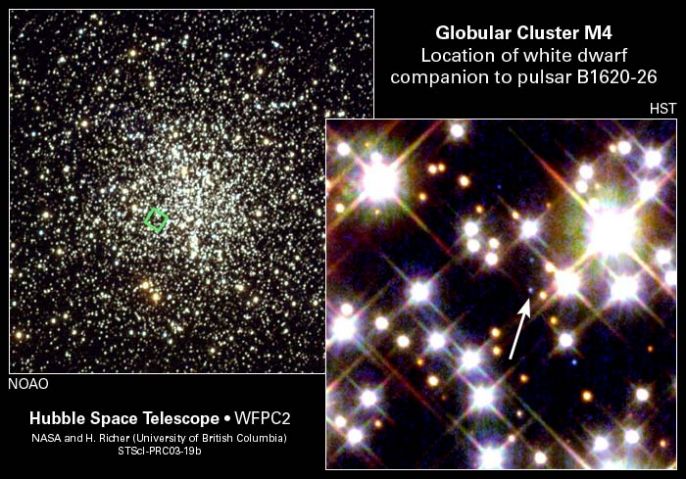Explanation: A planet, a white dwarf, and a neutron star orbit each other in the giant globular star cluster M4, some 5,600 light-years away. The most visible member of the trio is the white dwarf star, indicated above in an image from the Hubble Space Telescope, while the neutron star is detected at radio frequencies as a pulsar. A third body was known to be present in the pulsar/white dwarf system and a detailed analysis of the Hubble data has indicated it is indeed a planet with about 2.5 times the mass of Jupiter. In such a system, the planet is likely to be about 13 billion years old. Compared to our solar system's tender 4.5 billion years and other identified planets of nearby stars, this truly ancient world is by far the oldest planet known, almost as old as the Universe itself. Its discovery as part of an evolved cosmic trio suggests that planet formation spans the age of the Universe and that this newly discovered planet is likely only one of many formed in the crowded environs of globular star clusters.
1999 2000 2001 2002 2003 2004 2005 2006 2007 2008 2009 2010 2011 2012 2013 2014 2015 2016 2017 2018 2019 2020 2021 2022 2023 2024 2025 |
Yanvar' Fevral' Mart Aprel' Mai Iyun' Iyul' Avgust Sentyabr' Oktyabr' Noyabr' Dekabr' |
NASA Web Site Statements, Warnings, and Disclaimers
NASA Official: Jay Norris. Specific rights apply.
A service of: LHEA at NASA / GSFC
& Michigan Tech. U.
|
Publikacii s klyuchevymi slovami:
pulsar - white dwarf - extrasolar planet - neutron star - globular cluster - Pul'sar - belyi karlik - Planety u drugih zvezd - zvezda, neitronnaya - Sharovoe skoplenie
Publikacii so slovami: pulsar - white dwarf - extrasolar planet - neutron star - globular cluster - Pul'sar - belyi karlik - Planety u drugih zvezd - zvezda, neitronnaya - Sharovoe skoplenie | |
Sm. takzhe:
Vse publikacii na tu zhe temu >> | |
